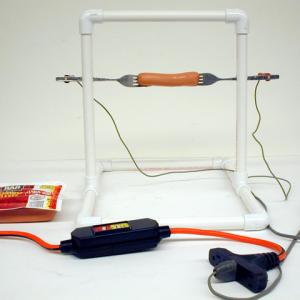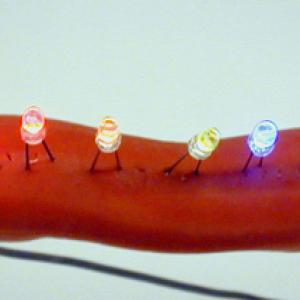College of Liberal Arts & Sciences
5F15.20 - Hot Dog Cooker
See also 5D15.20 in Chemistry and Physics of Everyday Experience.
Place the sliding forks on stands spaced at the appropriate distance to easily support a hot dog from each end. Once the hot dog is in place turn on the switch. After about 45 seconds visible steam should be seen coming from the hot dog. It should also turn colors as it cooks.
NOTE: While the switch acts as one safety, it is advisable that the apparatus be unplugged while placing the hot dog.
LED's may be placed along the length of the hot dog to show the voltage drop along the cooking hot dog resistor. An added enhancement is to use clear case LED's that run the full spectrum of colors (from Red to White).
- Wojciech Dindorf, "Dance of the Hot Dogs", TPT, Vol. 39, # 6, Sept. 2001, p. 336.
- Robert M. Graham and Howard S. Izawa, "Electrical Heating with a Nonconventional Resistance, A Cake", TPT, Vol. 16, # 3, March 1978, p. 181.
- Robert F. Neff, "Hot Dog Conduction, an Edible Experiment", TPT, Vol. 13, # 7, Oct. 1975, p. 50.
- E-425: "Hot Dog Cooker", DICK and RAE Physics Demo Notebook.
- Robert L. Wild, "Conductivity in Liquids and Hot Dogs", Low-Cost Physics Demonstrations, # 134, p. 79.
Disclaimer: These demonstrations are provided only for illustrative use by persons affiliated with The University of Iowa and only under the direction of a trained instructor or physicist. The University of Iowa is not responsible for demonstrations performed by those using their own equipment or who choose to use this reference material for their own purpose. The demonstrations included here are within the public domain and can be found in materials contained in libraries, bookstores, and through electronic sources. Performing all or any portion of any of these demonstrations, with or without revisions not depicted here entails inherent risks. These risks include, without limitation, bodily injury (and possibly death), including risks to health that may be temporary or permanent and that may exacerbate a pre-existing medical condition; and property loss or damage. Anyone performing any part of these demonstrations, even with revisions, knowingly and voluntarily assumes all risks associated with them.


